Treasured Stories of Hawai‘i Writers
Monday, 10:45 to 12:00, Lama Library Alcove
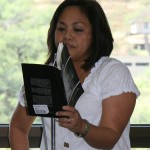
Kapi‘o File Photo
Lisa Linn Kanae, Gail N. Harada, Wing Tek Lum, and Kenneth Quilantang share poetry and prose. We asked these esteemed Hawaii writers whether it is the author or the content that qualifies work as Hawaii literature. Lum says, “I have a broad definition of Hawai’i literature. It can be because a poem is written by a local person, or because it is about Hawai’i, or because it is for a local audience.” Quilantang says, “You know why my stuffs stay Hawai‘i literature? Cause I went write um das why.” For people who say they don’t get poetry, Kanae says, “I empathize. I hated poetry until I learned how to read a poem. Poet- ry and literature can seem intimidating, which is silly. I think this stigma has something to do with the assumption that a poem always has a super secret message that a reader must decode. Not true. Reading a poem is about experiencing the images and emotions on the page.” Harada advises, “Poetry is like music–you’re not going to get or like every type of music you hear. I like poetry for what it can reveal, not for secret meanings. So look for what a poem reveals to you through its words. Look for poems that are real to you.”
Treasuring Our Music: Synthesizer Ensemble
Tuesday, 11:00 to 12:00, Ohia Cafeteria
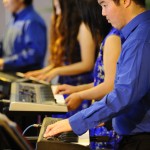
Kapi‘o File Photo
KapCC piano students offer songs from many countries, including a Disney medley, a jazz selection, the Vince Guaraldi “Linus and Lucy” theme, and ethnic pieces, both traditional and contemporary. Eight to 10 students will perform on keyboards, flute, guitar, baritone, and ukulele, according to Associate Profes- sor Anne Lum. Students look forward to this annual performance because they have the opportunity to share music from their homes: one student is performing for the third time, and another for the sixth. It becomes even more interesting when the audience is attentive and has come to listen to the music, rather than experience it as background during a meal, an approach Kapi‘o encourages its readership to adopt. “I try to highlight the talents of the students at hand,” says Lum, “so this class changes every semester, de- pending on who takes the course. It is always interesting and challenging to teach and arrange the music each semester for the students at hand–therefore never boring!”
International Film: The Great Passage
Tuesday, 6:30 to 8:30, Ohia Auditorium
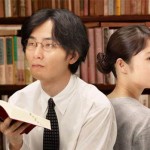
Photo: Fune-Amu.com
“Fune o Amu” is a 2013 Japanese film directed by Yuya Ishii, starring Ryuhei Mat- suda as dictionary editor Mitsuya Majime. From Wikipedia: With Majime on the editing team, the (dictionary publisher) plans to produce a new dictionary called “Daitokai” (“The Great Passage”) which would bridge the gap between people and the sea of words and would take years to complete. Back at his home, Majime meets Kaguya Hayashi (Aoi Miyazaki), his landlady’s granddaughter who has just returned from culinary school. He is struck by her beauty. Upon discovering this, the chief editor asks Majime to write the definition for the word “love.” Gary Goldstein of the Los Angeles Times says, “We witness the inevitable and unexpected changes in the characters as well as in the world around them. But it’s the power of words to enlighten and connect us that remains the constant and gives this charming film its special place on the shelf.” Justin Chang of Variety writes, “Performances are excellent across the board. Matsuda beautifully modulates his character’s long-arc transformation from socially awkward bookworm to respected leader of the enterprise.” Kapi‘o says check it out.
Wa Kei Sei Jaku: Japanese Tea Ceremony
Wednesday, 11:00 to 2:00, Ohia Cafeteria
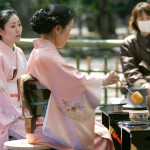
Kapi‘o File Photo
Students in JPNS 290 offer interactive displays illustrating the significance of the Jap-anese tea ceremony. According to Miki Hirano and Linda Fujiwaka, who will oversee the exhibit, the ceremony must be experienced in order for the true tranquility of the ritual to be appreciated: the perfecting of the movements with no extraneous motion, the appreciation for the beauty and loneliness of a fleeting instant, and of course, the taste of the tea itself.
“Ichi go, ichi ei” sums up a considerable portion of the Japanese aesthetic and is
a meaningful component of the tea ceremony. It means “this one moment, this one
meeting,” and underscores the value of pausing for a moment, even in the midst of daily struggle and stress, to enjoy the gift of the moment itself. The ceremony is built on manners, which can take some time to learn, but to those who ap- proach it more for its cultural value than its philosophical meaning, Hirano and Fujikawa repeat: “Ichi go, ichi ei.” Enjoy the moment however you will.
Kahikahealani Wight: Rainforest Pu‘uhonua
Thursday, 12:00 to 12:30, Lama Library Char Room
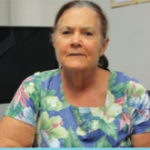
Kapi‘o File Photo
KapCC Associate Professor Kahi Wight reads from her ebook recounting a five-year journey to reclaim her Hawaiian language and culture on a Big Island volcano, where “the weather is always changing drastically, and you have to have a different way of thinking in order to see everything.” Wight’s story begins with a Hawaiian father and a New England mother, parents who discouraged her from learning the Hawaiian language; it continues when a house on a volcano practically claims her, where “there is a grass-roots approach to what is your kuleana to this land,” and “I was allowed peace to deal with my issue.”
Wight’s book is at times transcendental, at others romantic as it addresses issues of spir- ituality, responsibility, connectedness to our land and our ancestors, cultural identity, and personal growth. More information (including purchasing options) are available at rainforestpuuhonua.com.
Cerro Negro: Tessellations of Musical Treasures
Thursday, 10:00 to 10:30 and 11:00 to 11:30, Ohia Cafeteria
Spanish guitars, blended with Latin percussion, create the gypsy-influenced, acoustic sound of Cerro Negro. While enjoying the fusion of Flamenco, Brazilian, and jazz guitar techniques with Latin, Africa, and Middle-Eastern percussion, Cerro Negro’s music soars with passionate vocals embracing a village of rhythms, styles, and languages. Cerro Negro creates its own unique synergy by combining sounds from the roots of Flamenco music with cutting-edge instrumentation and orchestration.
Cerro Negro is from San Diego, CA and includes lead guitarist Dusty Brough, rhythm guitarist Frank Giordano, and percussionist/lead vocalist John Martin III. Brough is an exciting young guitarist who is captivating audiences with his virtuosity.
Giordano plays both Flamenco guitar and piano, switching up the group’s instrumen-tation throughout the performance. Martin performs on his custom percussion setup which includes instruments from around the world.
